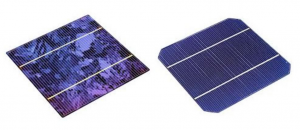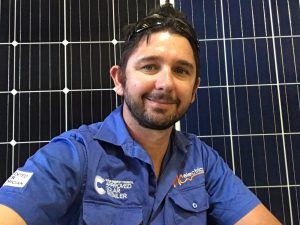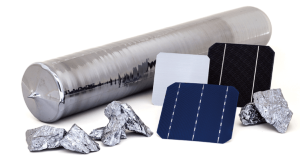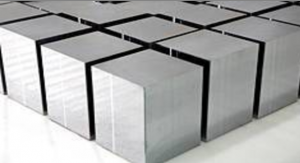Monocrystalline (left), Polycrystalline (right)
Monocrystalline vs Polycrystalline
The solar panel market has developed rapidly in the second half of 2016. We are seeing higher wattage panels at lower prices than ever before. With monocrystalline panels making a comeback, the face-off between monocrystalline and polycrystalline panels has erupted again. So which solar panel is better? Monocrystalline or Polycrystalline?
This post will briefly cover the manufacturing difference between the two cells technologies, (or more correctly “wafer technologies” as a wafer is a cell without the silver fingers and busbars). We’ll then look at how the industry has shifted it’s preference full circle and discuss temperature coefficient and module efficiency.

Poly VS mono wafer manufacturing
While both monocrystalline and polycrystalline use the same raw material, the process of manufacturing is different.
Monocrystalline manufacturing
Monocrystalline wafers are “grown” by seeding molten silicone and drawing it up from a quartz crucible while rotating it to form a cylindrical block. This process forms a single (mono) crystal cylindrical block. The cylindrical block is squared off except for the corners, and then finely sliced into wafers. The rounded corner results in the diamond patterns on the panel. The colour of the cell is a dark blue/black. Manufacturing a monocrystalline cell takes longer, requires higher temperatures, and produces more waste. This results in an increased manufacturing cost.
Polycrystalline manufacturing
Polycrystalline wafers are made by melting silicone chunks down in a mold to form brick-like ingots. It’s faster, requires less temperature and produces less waste material. The process forms multiple crystals on a block, that again is sliced into wafers. Several years ago the multi-crystal look was clearly visible as the cells would have a shattered appearance. Today, the average polycrystalline cell has a relatively consistent dark blue colour. The poly panel’s square cell easily distinguishes it from a mono panel with a diamond pattern.
The early days of Monocrystalline
When I started out working with solar in 2008, there seemed to be a clear-cut answer to which cell was better – or so we thought. Monocrystalline won hands down. With a glance over the specs, it was clear that Monocrystalline panels had a higher efficiency. Your 160-watt Solarfun panel was way more efficient than your 130-watt poly-panel. A no-brainer : we want more efficient monocrystalline panels, right?
Add to that the fact that a polycrystalline panel looked like shattered glass, while the mono panels had a nice black cell with trendy looking white diamonds. At a time when we were paying over $750 for a single 160w panel, monocrystalline panels were all the rage.
It wasn’t until 2011 when a sales company asked me to install the huge 215W LG polycrystalline panels, that the penny dropped.
“Sam, what are you selling polycrystalline rubbish for”
I asked in disgust.
“Here is tiny bit of an education for you”
replied the slimy sales manager with a upturned nose and a condescending tone.
…. Efficiency isn’t always king.”
At the time when 3kW systems were considered overkill, he had a point.
Monocrystalline to Polycrystalline
According to my recollection, around 2013 was the year that the industry transitioned from mono-crystalline to polycrystalline as the mainstream panel. How does one justify that the polycrystalline panel is better than a mono panel? Here are three reasons that come with a whiff of truth.
- Because every dollar counts.
Poly panels have always been cheaper than the same quality mono panels. However, that gap is decreasing. As a rule of thumb, polycrystalline panels in 2016 have been about 2 cents per watt cheaper than the same brand of monocrystalline panel. That means comparing the same brand and build quality, you will save about a $130 on a 6.5kW of panels. However, considering you would normally need more poly panels to make up the same size system, the saving of $130 could almost be gobbled up with the cost of extra rail to mount the panels, and extra labor to install them. We’re splitting hairs.
- You want your solar panels to double as roof insulation
As Poly panels are less efficient, you get to cover a larger area of your roof for the same size system. Covering a roof with solar panels can cause a difference to the temperature inside your home. I guess having 24 panels on your roof instead of 22 may theoretically be better. Kind of, sort of, not really.
- The legend of the temperature coefficient
You live in the desert and you are anally retentive about heat loss. As the story goes, poly panels perform better in higher temperatures. But let’s have a look at the specs of a 2016 panel and see how true the legend is.
What is temperature coefficient?
Contrary to what you may expect, panels work best at lunchtime on a cool windy sun shining summers day. A stinking hot summers day will reduce solar production. The figure used to measure the effect of heat on a solar panel is called the temperature coefficient. As stated, poly panels traditionally held the trump card in high heat. But it’s about time to re-examine that claim. Again I’ll pull out my Canadian Panel Specs:
Canadian 270W Monocrystalline temp coefficient Pmax. -0.41% / °C
Canadian 260W Polycrystalline temperature coefficient Pmax: -0.43% / °C
In this case, the Monocrystalline panel temperature coefficient is actually lower than the polycrystalline panel! As I looked around different specs, it seems the rule that monocrystalline panels work less efficiently in higher heat no longer applies. In fact monocrystalline panels today often have a lower temperature coefficient!
The Temperature coefficient myth busted
Does this make monocrystalline panels better? Let’s bust a myth.
Consider the two panels above where the monocrystalline panel has a temperature coefficient that is .02 percent lower than the poly. How much does that actually affect the performance of the panel?
Every degree the temperature goes over 25 degrees, we lose an additional .02 of a percent.
We’ll assume the worst case scenario that your solar panel is working on a ridiculous 50.7-degree day, (which was the Australian record set at Oodnadatta in South Australia in January 1960).
That’s 25.7 degrees higher than the standard test conditions. The cell temperature, will be 20 degrees hotter than that at a huge 70.7 degrees, or 45.7 degrees hotter than standard cell test conditions.
45.7 degrees by .02 percent is 0.914 of one percent of power loss. Instead of your panel running at 260W, it will loose an additional 2.37 watts. Considering a standard panel has a +5 watt power tolerance ,your labeled 260w panel may be a 265. A theoretical 2.37 watts in record Australian temperatures does not count for diddly squat.
But in case you think 2.37 watts per panel still counts for something, let’s look at it this way. Most of the systems we install today are oversized by up to 33 percent. In other words, we would install 6.6kW of panels on a 5kW inverter. At lunch time on 50.7 degree summers day, when all panels are firing, your inverter will be limited to 5kW anyway. The 2.37 W loss per panel is negated. If you are wondering about the efficiency loss on a 30-degree day mid-morning, I think you think too much. Ok, it’s 1.3-watt loss per panel.
The difference between temperature coefficient of most panels is so small it is not worth comparing. It can easily be negated by oversizing.
Myth busted. However, there is an exception. When you look at premium panels such as the Sunpower X series, they have a temperature coefficient of .3% / °C. On a 6.5kW system, if it’s 30-degrees celsius by 10am, you will generate an additional 163.5 watts compared to the one of the standard .4%/ °C panel. However, oversizing the array will again negate the temperature coefficient loss in the middle hours of a hot day.
Polycrystalline to Monocrystalline
Mono panels seem to be winning the temperature coefficient battle that wasn’t worth having. But it’s not temperature coefficient that is driving the focus back to Mono, it’s more practical than that. It’s module efficiency.
What is module efficiency
In short, module efficiency is just a measure of how much power you can pack into a given area. Let’s pull out the specs and have a look at what module efficiency means today.
- A Canadian 250w polycrystalline panel measures 1638 x 982 and it has a module efficiency of 15.54%
- A Canadian 280w monocrystalline panel measures 1650 x 992 and has a module efficiency of 17.11%
The Canadian 280w panel is only 1.7 percent larger, but it has 12 percent more power. The Canadian 280w mono panel, therefore, is more efficient.
However, if roof space is not an issue, then why should efficiency be? At a time when 3kW systems were considered huge, high-efficiency panels should not have been the focus. If you really do only need 3kW of panels on your huge roof today, and over the next 20 years – efficiency should not be king!
But the times they are a changing. Homeowners today are looking forward to harnessing solar energy to charge a not-so-future battery storage system or an electric vehicle. The amount of solar power you will be able to utilise will soon only be limited by the size of your roof. The need to harness more energy from your roof top has re-introduced the value of module efficiency. But it’s not all about module efficiency!
To get the most power on the average home, we have to consider that 6.66kW is the largest system we can put on a single phase home in Brisbane. More important than focusing on the biggest panel (highest efficiency), we should look at the biggest system on your roof. As it turns out, for the largest system we can install, we have a panel class sweet spot.
300w panels – 22 x 300w panels = 6600w (sweet spot, however rare in standard dimensions so the price is unreasonabley high)
290w panels – 22 x 290w panels 6380w (23 panels would be 6670, so we could not install this in Brisbane)
280w panels – 23 x 280w panels – 6440 (24 panels would be 6720, 23 often doesn’t work well with design.)
275 w panel – 24 x 275w panel = 6600w (sweet spot)
Conclusion
As the industry has shifted from Monocrystalline to Polycrystalline solar panels and back again, we’ve heard all kinds of stories about why one technology is better the next. Because of a simpler manufacturing process, Poly are sometimes a little bit more affordable. Don’t waste your time comparing temperature coefficients – the difference isn’t worth measuring. If you are comparing a 275w mono panel, to a 275w poly panel, don’t make your decision based on the type of cell. The only real advantage of Monocrystalline cells have is that they are able to be manufactured with a slighly higher efficiency. All this means is we can get higher wattage panels in the same surface area, or more power on a limited roof space. All things considered, just look for a quality panel that will allow the largest system design on your roof. We find (in 2017) a 275W panel is a sweet spot at the moment.






2 Responses
Hi James. I’d say 300W is the sweet spot atm. Wattage classes have increased rapidly in the last 12 months and our main line is a QCell 300W panel.
Hi Mark, If one has plenty of roof space and is planning a large array (say 10-20KW), where does the best value lie regarding panel wattage (regardless of mono/poly), when using say Trina for example? Is there a sweet spot in Trina module pricing? When you mention “300w.. however rare in standard dimensions so the price is unreasonably high” are you saying 300w panels are disproportionately expensive for what they are? Thanks! 🙂